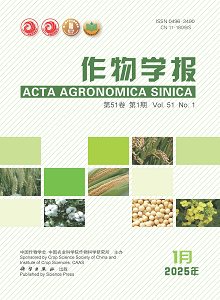不同生育期施钾对不同土壤质地冬小麦干物质积累和产量的影响
引用次数: 1
摘要
为了研究施钾对冬小麦籽粒产量形成的影响,以高产冬小麦品种台麦198为材料,在不同土壤质地上进行了试验。分析不同土壤质地条件下,不同时期施钾对冬小麦旗叶光合特性、干物质积累和分布以及籽粒产量的影响,安排了两个土质试验田[沙壤土(S)和粉质壤土(F)]和三个处理[不施钾肥(K0)、钾肥基施(播种时100%施用,K1)和分施(播种期50%施用+拔节期50%追肥,K2)]。结果表明,土壤质地和施钾量的交互作用对花后单株粒数、同化干物质和产量均有显著影响。在两种土壤质地条件下,施钾显著提高了冬小麦的产量,其中K2处理产量最高。与K1处理相比,K2处理增加了穗粒数、花后旗叶SPAD和净光合速率、花后茎干物质积累以及花后同化物向籽粒的转移。在沙壤土条件下,K2处理的籽粒产量分别比K1处理高12.4%和10.4%。在粉壤土条件下,籽粒产量分别比K1处理提高5.2%和5.4%。结果表明,拔节期钾肥基施改为50%基施50%追肥能显著提高小麦产量,沙壤土田小麦产量较高。本文章由计算机程序翻译,如有差异,请以英文原文为准。
Effects of applying potassium at different growth stages on dry matter accumulation and yield of winter wheat in different soil-texture fields
: To investigate the effects of potassium applying on the grain yield formation of winter wheat, the experiments were carried out on different soil textures with high-yield winter wheat variety Taimai 198. To analyze the effects of potassium application at different stages on winter wheat flag leaf photosynthetic characteristics, dry matter accumulation and distribution, and grain yield under different soil texture conditions, two soil texture test fields [sandy loam (S) and silty loam (F)] and three treatments [no potassium fertilizer (K0), potassium fertilizer base application (100% applicating at sowing, K1), and split application (50% applicating at sowing stage + 50% topdressing at the jointing stage, K2)] was arranged. The results showed that the interaction of soil texture and potassium application significantly affected the grain number per spike and dry matter assimilated after anthesis and grain yield. Under the two soil texture conditions, potassium application significantly increased the grain yield of winter wheat, and K2 treatment had the highest yield. Compared with K1 treatment, the grains number per ear, the SPAD and net photosynthetic rate of flag leaves after anthesis, the accumulation of dry matter per stem after anthesis, and the transfer of assimilation to the grain after anthesis were increased under K2 treatment. Under sandy loam conditions, grain yield of K2 treatment was by 12.4% and 10.4% higher than that of K1 treatment, respectively. Under silt loam conditions, grain yield was by 5.2% and 5.4% higher than that of K1 treatment. Those results indicated that wheat yield was significantly increased by changing potassium fertilizer base application to 50% base application with 50% topdressing at jointing stage, and the wheat yield was higher in sandy loam field.
求助全文
通过发布文献求助,成功后即可免费获取论文全文。
去求助
来源期刊

作物学报
Agricultural and Biological Sciences-Agronomy and Crop Science
CiteScore
1.70
自引率
0.00%
发文量
89
期刊介绍:
The major aims of AAS are to report the progresses in the disciplines of crop breeding, crop genetics, crop cultivation, crop physiology, ecology, biochemistry, germplasm resources, grain chemistry, grain storage and processing, bio-technology and biomathematics etc. mainly in China and abroad. AAS provides regular columns for Original papers, Reviews, and Research notes. The strict peer-review procedure guarantees the academic level and raises the reputation of the journal. The readership of AAS is for crop science researchers, students of agricultural colleges and universities, and persons with similar academic level.
 求助内容:
求助内容: 应助结果提醒方式:
应助结果提醒方式:


